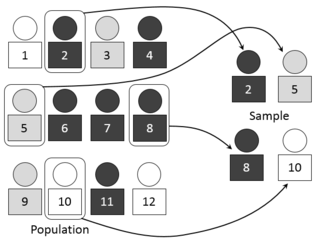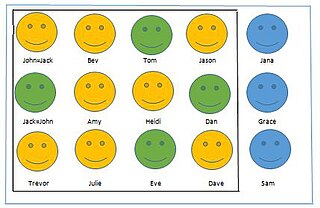Related Research Articles

In statistics, cluster sampling is a sampling plan used when mutually homogeneous yet internally heterogeneous groupings are evident in a statistical population. It is often used in marketing research.

A census is the procedure of systematically acquiring, recording and calculating population information about the members of a given population. This term is used mostly in connection with national population and housing censuses; other common censuses include censuses of agriculture, traditional culture, business, supplies, and traffic censuses. The United Nations (UN) defines the essential features of population and housing censuses as "individual enumeration, universality within a defined territory, simultaneity and defined periodicity", and recommends that population censuses be taken at least every ten years. UN recommendations also cover census topics to be collected, official definitions, classifications and other useful information to co-ordinate international practices.
In statistics, survey sampling describes the process of selecting a sample of elements from a target population to conduct a survey. The term "survey" may refer to many different types or techniques of observation. In survey sampling it most often involves a questionnaire used to measure the characteristics and/or attitudes of people. Different ways of contacting members of a sample once they have been selected is the subject of survey data collection. The purpose of sampling is to reduce the cost and/or the amount of work that it would take to survey the entire target population. A survey that measures the entire target population is called a census. A sample refers to a group or section of a population from which information is to be obtained

Frame Relay is a standardized wide area network (WAN) technology that specifies the physical and data link layers of digital telecommunications channels using a packet switching methodology. Originally designed for transport across Integrated Services Digital Network (ISDN) infrastructure, it may be used today in the context of many other network interfaces.
High-Level Data Link Control (HDLC) is a bit-oriented code-transparent synchronous data link layer protocol developed by the International Organization for Standardization (ISO). The standard for HDLC is ISO/IEC 13239:2002.

In statistics, quality assurance, and survey methodology, sampling is the selection of a subset or a statistical sample of individuals from within a statistical population to estimate characteristics of the whole population. Statisticians attempt to collect samples that are representative of the population. Sampling has lower costs and faster data collection compared to recording data from the entire population, and thus, it can provide insights in cases where it is infeasible to measure an entire population.
In survey methodology, systematic sampling is a statistical method involving the selection of elements from an ordered sampling frame. The most common form of systematic sampling is an equiprobability method.
Questionnaire construction refers to the design of a questionnaire to gather statistically useful information about a given topic. When properly constructed and responsibly administered, questionnaires can provide valuable data about any given subject.
Survey methodology is "the study of survey methods". As a field of applied statistics concentrating on human-research surveys, survey methodology studies the sampling of individual units from a population and associated techniques of survey data collection, such as questionnaire construction and methods for improving the number and accuracy of responses to surveys. Survey methodology targets instruments or procedures that ask one or more questions that may or may not be answered.
An opinion poll, often simply referred to as a survey or a poll, is a human research survey of public opinion from a particular sample. Opinion polls are usually designed to represent the opinions of a population by conducting a series of questions and then extrapolating generalities in ratio or within confidence intervals. A person who conducts polls is referred to as a pollster.
FrameNet is a group of online lexical databases based upon the theory of meaning known as Frame semantics, developed by linguist Charles J. Fillmore. The project's fundamental notion is simple: most words' meanings may be best understood in terms of a semantic frame, which is a description of a certain kind of event, connection, or item and its actors.
In the theory of finite population sampling, a sampling design specifies for every possible sample its probability of being drawn.
In statistics, non-sampling error is a catch-all term for the deviations of estimates from their true values that are not a function of the sample chosen, including various systematic errors and random errors that are not due to sampling. Non-sampling errors are much harder to quantify than sampling errors.
In statistics, a simple random sample is a subset of individuals chosen from a larger set in which a subset of individuals are chosen randomly, all with the same probability. It is a process of selecting a sample in a random way. In SRS, each subset of k individuals has the same probability of being chosen for the sample as any other subset of k individuals. Simple random sampling is a basic type of sampling and can be a component of other more complex sampling methods.
In survey methodology, the design effect is a measure of the expected impact of a sampling design on the variance of an estimator for some parameter. It is calculated as the ratio of the variance of an estimator based on a sample from an (often) complex sampling design, to the variance of an alternative estimator based on a simple random sample (SRS) of the same number of elements. The can be used to adjust the variance of an estimator in cases where the sample is not drawn using simple random sampling. It may also be useful in sample size calculations and for quantifying the representativeness of a sample. The term "design effect" was coined by Leslie Kish in 1965.

Coverage error is a type of non-sampling error that occurs when there is not a one-to-one correspondence between the target population and the sampling frame from which a sample is drawn. This can bias estimates calculated using survey data. For example, a researcher may wish to study the opinions of registered voters by calling residences listed in a telephone directory. Undercoverage may occur if not all voters are listed in the phone directory. Overcoverage could occur if some voters have more than one listed phone number. Bias could also occur if some phone numbers listed in the directory do not belong to registered voters. In this example, undercoverage, overcoverage, and bias due to inclusion of unregistered voters in the sampling frame are examples of coverage error.
In survey sampling, Total Survey Error includes all forms of survey error including sampling variability, interviewer effects, frame errors, response bias, and non-response bias. Total Survey Error is discussed in detail in many sources including Salant and Dillman.
With the application of probability sampling in the 1930s, surveys became a standard tool for empirical research in social sciences, marketing, and official statistics. The methods involved in survey data collection are any of a number of ways in which data can be collected for a statistical survey. These are methods that are used to collect information from a sample of individuals in a systematic way. First there was the change from traditional paper-and-pencil interviewing (PAPI) to computer-assisted interviewing (CAI). Now, face-to-face surveys (CAPI), telephone surveys (CATI), and mail surveys are increasingly replaced by web surveys. In addition, remote interviewers could possibly keep the respondent engaged while reducing cost as compared to in-person interviewers.
Online content analysis or online textual analysis refers to a collection of research techniques used to describe and make inferences about online material through systematic coding and interpretation. Online content analysis is a form of content analysis for analysis of Internet-based communication.
An area sampling frame is an alternative to the most traditional type of sampling frames.
References
- 1 2 3 4 5 6 7 8 9 10 Carl-Erik Särndal; Bengt Swensson; Jan Wretman (2003). Model assisted survey sampling. Springer. pp. 9–12. ISBN 978-0-387-40620-6 . Retrieved 2 January 2011.
- ↑ Raymond James Jessen (1978). Statistical survey techniques . Wiley. ISBN 9780471442608 . Retrieved 2 January 2011.[ page needed ]
- ↑ Salant, Priscilla, and Don A. Dillman. "How to Conduct your own Survey: Leading professional give you proven techniques for getting reliable results" (1995)
- ↑ Turner, Anthony G. "Sampling frames and master samples" (PDF). United Nations Secretariat. Retrieved December 11, 2012.
- 1 2 Roger Sapsford; Victor Jupp (29 March 2006). Data collection and analysis. SAGE. pp. 28–. ISBN 978-0-7619-4363-1 . Retrieved 2 January 2011.
- ↑ Peter L. Bernstein (1998). Against the gods: the remarkable story of risk . John Wiley and Sons. pp. 118–. ISBN 978-0-471-29563-1 . Retrieved 2 January 2011.
- ↑ Leslie Kish (1995). Survey sampling. Wiley. ISBN 978-0-471-10949-5 . Retrieved 11 January 2011.[ page needed ]